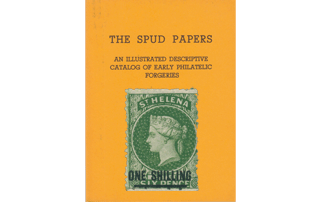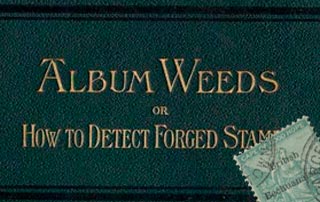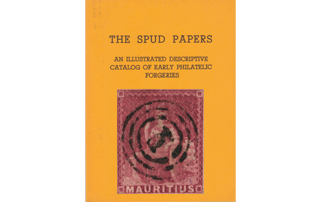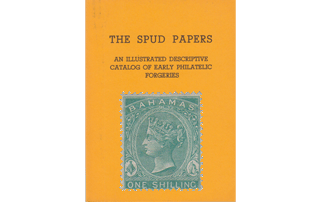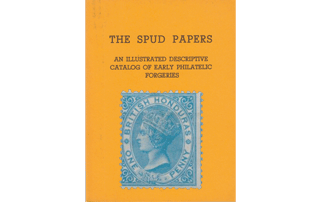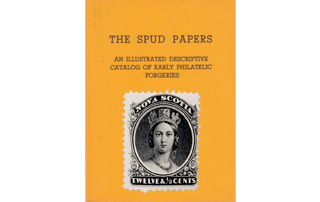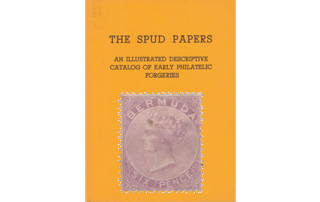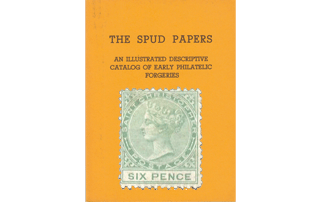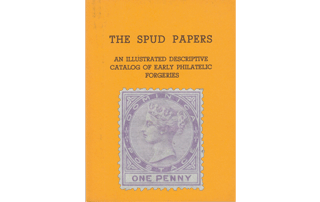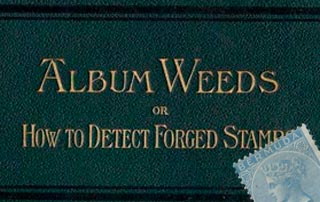


 1865-66. 1d., 2d., 6d. & 1s.
1865-66. 1d., 2d., 6d. & 1s.
The head on these stamps seems to be a favorite with the engravers, and it is to be found on a number of our colonial stamps, such as Dominica, St. Christopher, etc. All the forgeries bearing an imitation of this head, which will be found described in various parts of this work, have a very strong family likeness, even if they are not absolutely identical; and therefore, when my readers have become well acquainted with the forgeries for one of these countries, it will need but an instant’s inspection to enable them to detect a forgery for any of the others.
Genuine
Engraved in epargne, on thin, shiny, rather hard and transparent white wove paper; watermarked crown and CC, and machine-perf. 14, though the is. is also found perforated 14 x 12 1/2. The front pearl of the diadem just touches the seventh of the horizontal lines of shading of the background, counting from the top. There are nine thick lines of shading, below the lowest point of the front of the neck, with indications of a short, tenth line at the bottom. The white ring which surrounds the central medallion is exactly the same width all the way round. The hair completely hides the corner of the eyebrow; and it stops short under the front thistle, not coming up to the front of the forehead at all. There are six thick lines of shading, and one thinner and shorter one, from the top of the eyebrow to the upper eyelid. The front of the portrait, from the top of the forehead to the point of the neck, is not outlined, but simply formed by the stoppage of the horizontal lines of the background. The ornaments on the top of the diadem are: pearl, thistle, pearl, shamrock, pearl, thistle, pearl. All the pearls are taller than the shamrock and thistles. There are three distinct jewels along the base of the diadem – a diamond-shaped one between two oblong ones. The ear is shaded all over, and the lobe hangs down. The shading on the neck does not reach quite to the front, leaving a white space all down the front of the neck and throat. The lower lip is shaded with five oblique lines, and the nose is shaded all over, except a tiny white line just down the front. There are 17 transverse lines of shading on the neck, counting down the front; and most copies show indications of an eighteenth line. The profile of the forehead curves backwards, so that if a perpendicular line were let fall from the place where the forehead goes into the coronet, it would cut almost centrally through the eyeball.
First Forgery
Lithographed, on moderately stout, yellowish-white wove paper, no watermark, badly pin-perforated 12J, in oval holes. The front pearl on the diadem touches the seventh line of shading from the top, as a rule, like the genuine, but there is often an eighth line visible. There are only eight lines of the background to be seen, below the lowest point of the front of the neck. The white ring which surrounds the central medallion is wider on the right side than on the left. The hair is brushed almost entirely clear of the eyebrow, and it can be traced up to the very front of the forehead, below the diadem. There seem to be from five to seven lines of shading from the top of the eyebrow to the upper eyelid, but only two of them are thick, and the rest muddled and faint. The whole of the portrait is outlined. The front thistle on the top of the diadem is much smaller than the back one, and the back one is rather indistinct, and stands up very nearly as high as the pearls each side of it. The shamrock looks like a jietir-de-lys. The diamond-shaped jewel at the base of the diadem is tolerably distinct, but the oblong jewels each side of it are mere blotches in the shading. The rim of the ear is almost entirely white, and there is no lobe. The lines of shading in front of the neck go quite across, for the most part, so that there is no white space down the front of the throat. The lower lip is not shaded. There are about 15 lines of shading on the neck, counting down the front. The lines of shading in the background are ragged, and somewhat blurred; very different from the firm and clear-cut lines of the genuine.
Second Forgery
Lithographed, on stout, very white wove paper, no watermark, pin-perf. 12, in oval holes. The front pearl on the diadem touches the seventh of the horizontal lines of shading, counting from the top ; but this is difficult to see, as, in this forgery, both the first and second pearls are covered over by the horizontal lines of shading, so that they are almost invisible. There are nine clear lines of shading below the lowest point of the front of the base of the neck. The white ring round the medallion is broad in front of the upper part of the face, and narrow below the base of the back of the neck. The hair covers merely the extreme end of the eyebrow, and it can be traced forwards to the very front of the forehead, below the diadem. There are about five lines of shading from the top of the eyebrow to the upper eyelid, three of them very thick. The back of the neck is strongly outlined, and there is a very faint outline round most of the rest of the portrait. The first two pearls on the diadem are, as I said, covered by the horizontal lines of shading, and are thus almost invisible. The front thistle looks like a white pearl, with sometimes a shaded pearl hanging above it. The shamrock is smudgy, and the last thistle is very thin. The jewels appear to be a double diamond, between two single ones. The shading in front of the neck is too short, and leaves an exaggerated, white line down the front of the throat. The lower lip is shaded with two horizontal lines, and the lower part of the nose is not shaded. There are thirteen thick lines of shading down the neck, counting in front, and between every two thick lines there is a very thin one. The profile of the forehead is quite vertical, and a perpendicular line, drawn down from the place where the forehead goes into the coronet, would pass clear to the left of the eyeball.
Third Forgery
This is by far the poorest of the lot. Lithographed, on very thin, very white wove paper, no watermark, unperforated. The front pearl of the diadem appears to touch the sixth line of shading from the top, but the lines are coarse and smudged. There are ten lines of shading below the lowest point of the front of the neck, and the lowest two are blotched together. The white ring surrounding the central medallion is very narrow near the front of the coronet, and opposite the front point of the neck; indeed, in the latter place, some of the lines of shading actually cut across the white ring. It is broadest towards the top of the back of the head. The hair is brushed very nearly clear of the eyebrow. It does not come to the front of the forehead, but resembles the genuine. There are only four lines of shading from the top of the eyebrow to the upper eyelid, and they are blotched together. There is a strong outline all round the portrait. There are three thistles, instead of a shamrock between two thistles, on the top of the diadem, and the first two thistles are much higher than the pearls. The jewels at the base of the diadem look like three diamonds, but the front one is very shapeless. The last one, however, is evidently a diamond, instead of an oblong. The ear is very indistinct, and very badly shaped ; it is shaded all over, like the genuine. The lines of shading across the neck are too short, leaving an exaggerated white line down the front of the throat. The lower lip is unshaded. There are only five very short lines of shading on the nose, so that it is almost entirely white. It is of a bad shape, hooked instead of aquiline. The front of the face is entirely unshaded. There are only eight coarse lines of shading across the neck, counting from the front. It will be seen that some of the points in this forgery agree with the genuine, and yet it is not nearly so good a counterfeit as the two already described. I first met with this forgery in 1891, but I fancy it is considerably older than that.
Postmarks
Genuine.—1, 29, 55 (with three lines, instead of four, at top and bottom).
First Forgery.—54, with blank center.
Second Forgery.—A portion of a very large circle.
Third Forgery.—Uncancelled.
 Issue of 1874. 3d. on 1d., red; 3d. on 1s., green. Surcharge in fancy capitals.
Issue of 1874. 3d. on 1d., red; 3d. on 1s., green. Surcharge in fancy capitals.
These are the only two values to be found with this surcharge.
Genuine
The surcharge is in the ornamental, shaded or outlined letters, shown in the illustration. From the left top corner of the T to the right top corner of the final E, the surcharge measures 23 1/2 mm. The letters are 2 mm. high, measured parallel with their slope. The P of PENCE has a top like an ordinary capital P, without any curly line at the back.
First Forgery
I consider this a dangerous counterfeit. The length of the surcharge, measured as before, is 24 mm.; and the height is 1 3/4 mm. I have a 2d. with this surcharge, which is, of course, bogus.
Second Forgery
This is easy to detect. The surcharge measures 23 3/4 by a little over 1 3/4 mm., but the test is the P, which has a curly head, like a script P.
Postmarks
Genuine.—As before.
Forged.—The surcharge only being forged, the stamps bear genuine cancellations.
 1874. 3d. on Is., green. Surcharge in Roman capitals.
1874. 3d. on Is., green. Surcharge in Roman capitals.
Genuine
From the left top corner of the T to the right top corner of the final E, the surcharge measures exactly 24 mm.; and, from the outside edge of the second E of THREE to the edge of the upright stroke of the P, there is a space of a shade over 1 1/2 mm. The serif to the right side of the head of the T hangs down level with the cross-bar to the H. The head and tail of each E come very close together. The space between them is not more than 1/4 mm.
Forged
Measured as before, the surcharge is 231/2 mm. long, and the space between the words a shade over 2 mm. The serif to the right side of the T does not come down so low as the cross-bar of the H. The head and tail of each E are about 1/2 mm. apart. I have this surcharge on the 1d., which is bogus.
Postmarks
Genuine.—As before
Forged.—The postmarks are genuine.


 1875. 1d. on 2d., blue; 1d. on 3d., buff; 1d. on Is., green. Surcharge in ordinary capitals and lower case.
1875. 1d. on 2d., blue; 1d. on 3d., buff; 1d. on Is., green. Surcharge in ordinary capitals and lower case.
Genuine
The E of PENNY is exactly under the centre of the O of ONE. A line drawn down, along the first stroke of the N of ONE, would cut centrally through the first N of PENNY; and a line drawn upwards, along the last stroke of the last N, would cut centrally through the E of ONE. The distance between the two words is 2 1/2 mm.
Forged
The E of PENNY is plainly to the left of the center of the O of ONE. A line drawn down, along the first stroke of the N of ONE, would pass along the second stroke of the first N of PENNY; and a line drawn upwards, along the last stroke of the last N, would cut through the E of ONE, decidedly to the left of its center. The distance between the words is 2 1/2 mm.
It will be seen from the above that the genuine and forged surcharges are practically identical as to type, but, in the forgery, the ONE is not placed in exactly the same position above the PENNY as in the genuine.
Postmarks
Genuine.—As before
Forged.—The forgeries have genuine postmarks.
Bogus Stamps
I have the 1d. and 2d. surcharged in two lines, THREE PENCE. These are altogether bogus.
From: ‘Album Weeds’, 3rd edition by R. B. Eareé. 1906
 1864. 1 Shilling, Green.
1864. 1 Shilling, Green.
